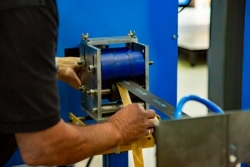Specifying essential ironmongery for fire doors

Posted on 21/10/2022
Mike Sutcliffe, Business Development Manager of Vanquish Hardware Protection, discusses what to look for in the specification of essential ironmongery for fire doors.
Architectural hardware is specified based on three main principles – the type of building, the building design, and the type of finish that is required to complement the design and period of the property.
This applies to all doors within a building, including fire doors. A fire door should be designed to fit in with the building design and the fixtures should match with the rest of the doors.
There is one critical difference, though – all essential hardware fitted to a fire door must be CE/UKCA marked and been tested to a relevant British or European standard such as BS 476:22 or EN 1634-1.
Fire door testing must be carried out at a UKAS accredited laboratory in which the entire doorset, including essential hardware, is subject to specific burning conditions on a full-scale furnace.
This essential hardware plays a vital role in the performance of the fire door to prevent the spread of flames and heat to adjacent rooms.
When essential hardware is morticed into timber fire resistant doorsets, the integrity is compromised as the insulating timber is replaced with metallic components which are excellent heat conductors. Intumescent protection provides additional insulation around metallic components and helps to resist the transfer of heat from one side of the door to the other by expanding upon exposure to heat, creating an insulating foam and sealing any voids created from the rebating process.
However, few people understand the differences between intumescent materials and currently there is no internationally recognised standard for intumescent hardware protection products.
It is also possible for intumescent materials to be swapped out to other brands if they are the same thickness and material type, but it must not be assumed that each brand of graphite-based intumescent is interchangeable.
This is because graphite-based intumescent can contain varying quantities and grades of intercalated graphite and expansion ratios and activation temperatures vary between compounds.
It is also unlikely that manufacturers will disclose how much graphite is in their products which makes comparing materials difficult without a side-by-side test.
It is imperative that installers check any test evidence or certification to understand what type and quantity of intumescent is necessary to be compliant.
It is also recommended to only use intumescent that has been independently assessed by a third party which ensures the products have been tested to the relevant standards and the manufacturer has quality management systems in place to ensure a consistent product.
For more information, visit https://www.vanquish-hp.co.uk/ or call 01725 578020.
